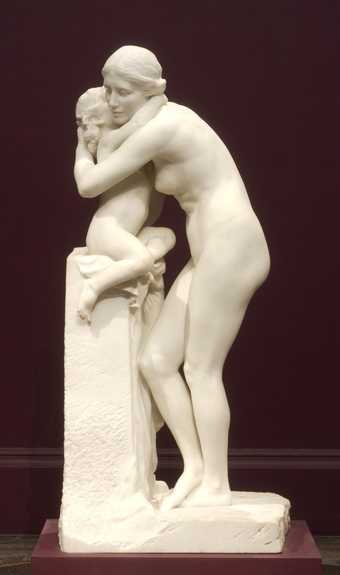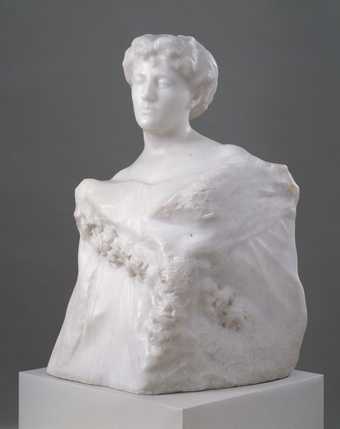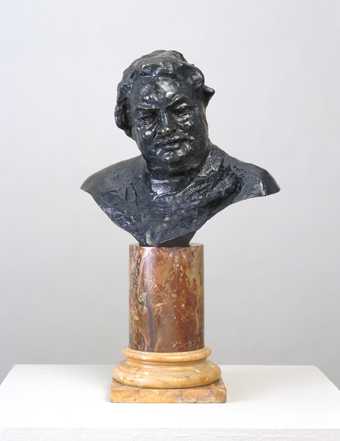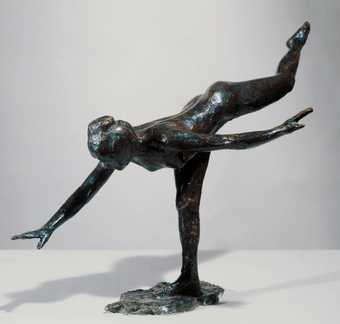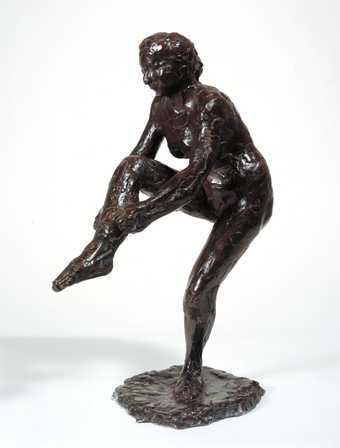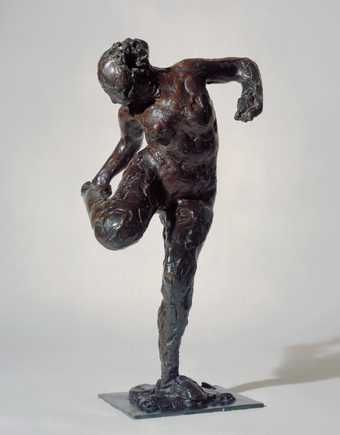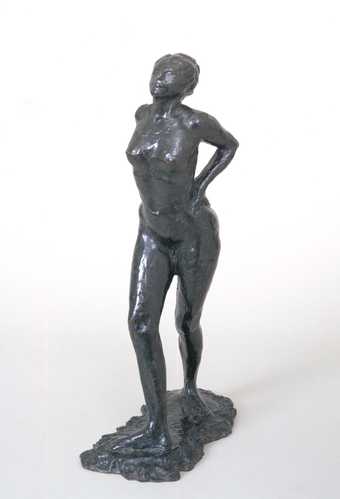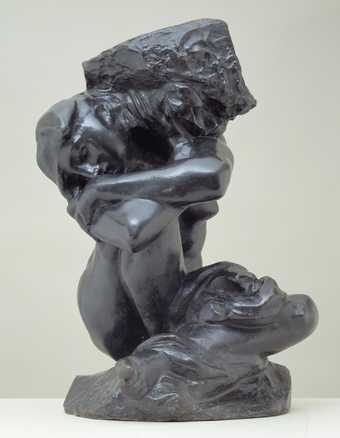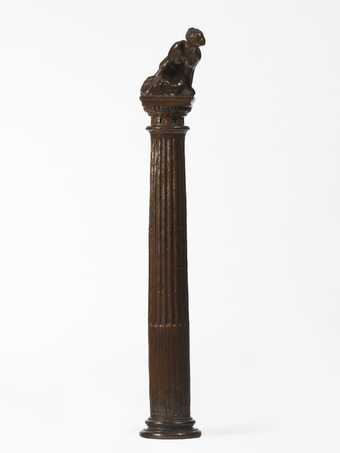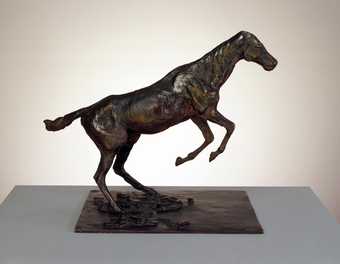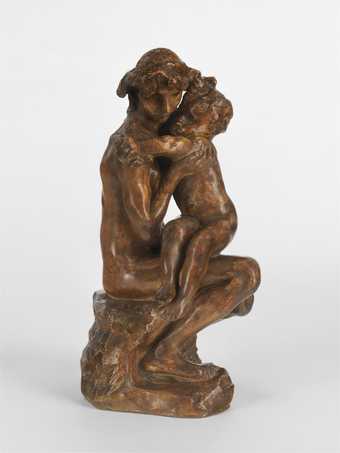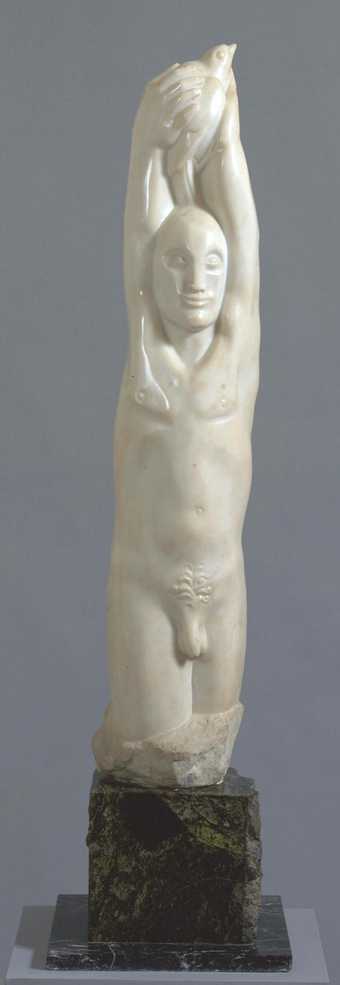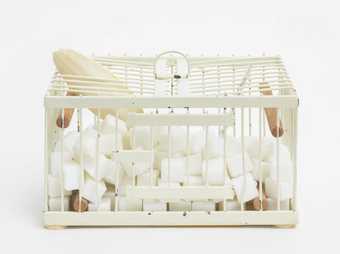Not on display
- Artist
- Auguste Rodin 1840–1917
- Original title
- Le Baiser
- Medium
- Pentelican marble
- Dimensions
- Object: 1822 × 1219 × 1530 mm, 3180 kg
- Collection
- Tate
- Acquisition
- Purchased with assistance from the Art Fund and public contributions 1953
- Reference
- N06228
Display caption
The Tate’s The Kiss is one of three full-scale versions made in Rodin’s lifetime. Its blend of eroticism and idealism makes it one of the great images of sexual love. However, Rodin considered it overly traditional, calling The Kiss ‘a large sculpted knick-knack following the usual formula.’ The couple are the adulterous lovers Paolo Malatesta and Francesca da Rimini, who were slain by Francesca’s outraged husband. They appear in Dante’s Inferno, which describes how their passion grew as they read the story of Lancelot and Guinevere together. The book can just be seen in Paolo’s hand.
Gallery label, August 2004
Does this text contain inaccurate information or language that you feel we should improve or change? We would like to hear from you.
Catalogue entry
Auguste Rodin 1840-1917
N06228 Le Baiser (The Kiss) 1901-4
Inscribed 'A. Rodin' r.side of base
Pentelican marble, 71 ¾ x 48 x 60 ¼ (182 x 102 x 153)
Purchased from Mrs Tremlett (Grant-in-Aid), with the aid of the NACF and public contributions 1953
Prov:
Edward Perry Warren, Lewes (commissioned from the artist through the Carfax Gallery, London); Warren sale, Lewes House, Lewes, 24 October 1929, lot 614 repr.; bt. in at £5,500; H. Asa Thomas, Lewes, c.1929; Mrs Pamela Tremlett, Lewes, 1953
Exh:
Sixth Exhibition, International Society, London, January-March 1906 (1); on loan to the Cheltenham Art Gallery 1933-9, and to the Tate Gallery from 1939 until acquired
Lit:
Frederick Lawton, The Life and Work of Auguste Rodin (London 1906), pp.62-3, 74, 109-10, 184, the Musée Rodin marble repr. facing p.185; A. Seaton Schmidt, 'A Note on some Recent Portrait Busts and Other Work by Auguste Rodin' in Studio, XLII, 1908, p.184; Muriel Ciolkowska, Rodin
(London 1912), p.83; S. Lami, Dictionnaire des Sculpteurs de l'Ecole Française au Dix-Neuvième Siècle (Paris 1921), Vol.4, p.171; Léonce Bénédite, Rodin
(London 1924), p.30, Musée Rodin marble repr. pls.41-2; William Rothenstein, Men and Memories (London 1931), Vol.1, pp.370-2; Edmond and Jules de Goncourt, Journal
(Paris 1936), Vol.7, p.183; Jacques-Emile Blanche, Portraits of a Lifetime (London 1937), p.117; Osbert Burdett and E.H. Goddard, Edward Perry Warren (London 1941), pp.257-63; Robert Descharnes and Jean-François Chabrun, Auguste Rodin (London-Melbourne 1967), pp.132-5, Musée Rodin marble repr. in colour p.131; Ionel Jianou and C. Goldscheider, Rodin
(Paris 1969), p.100, Musée Rodin marble repr. pls.54-5
Repr:
Art Journal, 1906, p.71; The Tate Gallery (London 1969), p.101
This group appears in relief in the first sketch for the 'Gates of Hell' in the centre of the left-hand door panel. It was at that time entitled 'Faith' and represented Paolo and Francesca from Dante's Inferno; as pendant to it on the right-hand panel appeared a woman with a child on her lap, as if Rodin had in mind a juxtaposition of sexual and maternal love. In 1886 Rodin made a half life-size version of this group in the round (under the title 'The Kiss'), and in 1887 was commissioned by the French State to execute the group in marble on a scale larger than life. Edmond de Goncourt recorded in his journal on 26 February 1888 that the sculptor had complained to him of the difficulty of enlarging a work conceived originally on a smaller scale and said that he would not have the time to prepare 'The Kiss' as he wished. However that be, the large marble was not ready until ten years later, when it was exhibited at the Salon de la Société Nationale of 1898 at the same time as the 'Balzac' (and is now in the Musée Rodin). Like Rodin's other marbles, it was carved mainly by another sculptor working under his direction: in this case by Jean Turcan (1846-95), a good sculptor represented at the former Musée du Luxembourg by a heroic marble group of 'The Blind Man and the Paralytic'. The marble (provided by the Beaux-Arts) is of poor quality, but the carving is excellent. According to reports in the Sunday Graphic and several other papers, the man who posed for 'The Kiss' was Liberio Nardone and the woman was named Carmen. Nardone also modelled for Bourdelle and later for Germaine Richier. In the Sunday Graphic of 11 November 1956 there is a photograph of him standing beside the marble of 'The Kiss' in the Musée Rodin and his age is then given as 88. Carmen, who also continued modelling into her old age, died about 1950.
The version of 'The Kiss' now at the Tate was commissioned from Rodin in the autumn of 1900 by the Anglo-American antiquarian Edward Perry Warren. The terms of the contract (which have been published by Burdett and Goddard, op. cit., p.259) were as follows:
- M. E.P. Warren agrees with M. A. Rodin through the intermediary of Carfax & Co. on the execution in the finest possible marble of his group 'The Kiss'.
- The price of the work is 20,000 francs, and the marble will cost 5,000 francs.
- M. Rodin will choose the marble.
- The genital organ of the man must be completed.
- The time agreed must not exceed 18 months.
- The work must be considered fully equal to the original in the Musée du Luxembourg. If M. Rodin wishes to make further pieces he can do so.
- Payment will be made en bloc on delivery of the finished work, to Lewes, England.
- Advances can be made from time to time as the work progresses.
In fact, the marble was still being quarried the following Easter and the group was not pronounced finished and ready for sending until July 1904. It was carved by Rigaud, the sculptor who had carved 'Phoebus-Apollo and his Horses' on the pedestal of Rodin's monument to Claude Lorrain at Nancy, but according to Jacques-Emile Blanche, Rodin finished it himself.
Two other similar marbles exist. The first (executed at roughly the same time as the present work) is in the Carlsberg Glyptotek in Copenhagen. It was commissioned by Carl Jacobsen, the founder of the Museum, in 1902, and executed in 1902-3 as it arrived at the Museum on 18 August 1903. It was paid for on March 1904 and cost 20,000 francs, plus 4,500 francs for the marble. The name of the sculptor who carved it was Dolivet.
The fourth and last marble was executed some years after Rodin's death for the Rodin Museum in Philadelphia erected by Jules E. Mastbaum: it was carved by the sculptor H. Gréber and is dated 1929.
When Warren left Lewes in 1913 he offered 'The Kiss' to the Lewes Town Hall as a loan, but its public exhibition caused local puritans to make so many objections that it had to be surrounded by a railing and covered with a sheet; and after only two years it was returned to the owner. It then stood until 1933 in the dim light of the coach house at Lewes House, there being no room for it indoors. In 1933 H. Asa Thomas offered it on loan to the Cheltenham Art Gallery, where it remained until 1939, when it entered the Tate.
Although the last payment was not made until 1955, it became part of the collection from the date of the first payment in 1953.
Published in:
Ronald Alley, Catalogue of the Tate Gallery's Collection of Modern Art other than Works by British Artists, Tate Gallery and Sotheby Parke-Bernet, London 1981, pp.646-8, reproduced p.646
Film and audio
Explore
- emotions, concepts and ideas(16,416)
-
- emotions and human qualities(5,345)
-
- love(516)
- characters(438)
- reading, writing, printed matter(5,159)
-
- book - non-specific(1,954)
- actions: expressive(2,622)
- sex and relationships(833)
-
- infidelity(100)
You might like
-
William Robert Colton The Springtide of Life
1903 -
Sir Hamo Thornycroft The Kiss
1916 -
Auguste Rodin Mrs Charles Hunter
1906 -
Auguste Rodin Balzac
1892 -
Auguste Rodin Lord Howard de Walden
c.1905–6 -
Edgar Degas Grande Arabesque
c.1885–90, posthumous cast -
Edgar Degas Dancer Putting on her Stocking
c.1900, posthumous cast -
Edgar Degas Dancer Looking at the Sole of her Right Foot
?1910–11, posthumous cast -
Edgar Degas Dancer at Rest, her Hands on her Hips, Right Leg Forward
c.1890, cast 1919–20 -
Auguste Rodin The Fallen Caryatid Carrying her Stone
c.1880–1, cast 1950 -
Auguste Rodin Woman on a Column
c.1900–3 -
Edgar Degas Horse Clearing an Obstacle
c.1887–8 -
Auguste Rodin Brother and Sister
1891 -
Maurice Lambert Man with a Bird
1929 -
Marcel Duchamp Why Not Sneeze Rose Sélavy?
1921, replica 1964



